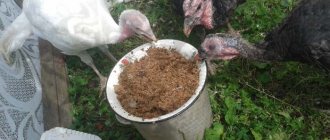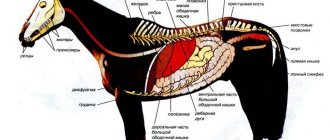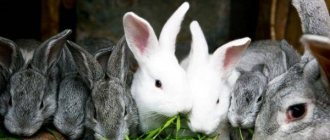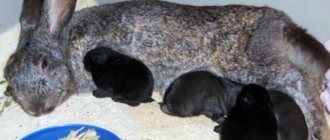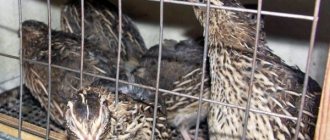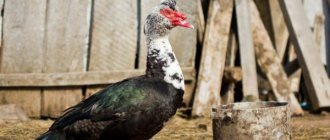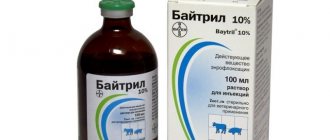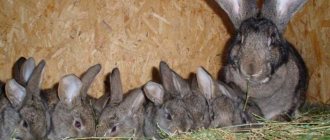» Livestock » Rabbits » Feeding rabbits in winter
0
2212
Article rating
For the proper development of rabbits, it is important to choose a balanced diet. Feeding rabbits in winter is not difficult, but the process has a number of features, the observance of which determines the processes of reproduction and vital activity.
Feeding rabbits in winter
Feeding rabbits in winter
Preparing the right diet is the basis for successfully raising rabbits. In order for animals to receive exactly those feeds that have a positive effect on their growth and productivity, the structure of the body and habits of the animals should be studied in advance.
Note: The main feature of animals is that their front teeth grow very quickly. In just one week they can increase by 3 mm, so they need to be ground down regularly. This explains why rabbits are constantly gnawing on things. Taking into account this feature, in addition to the main succulent, coarse and concentrated feed, the livestock should be given tree branches tied into dense brooms. This way, animals will be able to chew on them without unnecessary discomfort, grinding down their teeth naturally.
In addition, rabbits have an unusual structure of the digestive tract: long intestines and practically undeveloped stomach muscles. Because of this, for normal digestion of food, the stomach must be constantly filled with food. Accordingly, the amount of feed should be sufficient to ensure constant saturation. It is important to consider that an incorrectly formulated diet can weaken the immunity of animals and lead to a surge in infectious and parasitic diseases, therefore, crushed tree bark, branches, leaves or hay should be present in rabbit food at any time of the year (Figure 1).
Figure 1. In winter, animals especially need nutrients
In general, rabbits can be called unpretentious animals in terms of feeding. However, if you plan to grow them year-round, you will have to take care of preparing the correct winter diet.
Useful tips
Professional breeders claim that every novice rabbit breeder will be able to figure out what to feed their rabbits in winter. But in order for feeding to be balanced and correct, you need to adhere to the following recommendations:
- If food is poorly absorbed by the long-eared digestive system, it needs to be soaked in water for 2-3 days. This principle applies to hard grains, which form an important part of the winter diet.
- When preparing branches for the winter, you need to give up bird cherry, apricot, elderberry and buckthorn. Eating such food can lead to severe poisoning of animals. It is also better not to feed rabbits with tomato or potato tops. Tomato vegetation is a dangerous product, especially at the flowering stage.
When raising rabbits, you need to remember that these animals, although not picky, are vulnerable to various diseases due to the wrong choice of diet. Their digestive system is designed in such a way that the lack of a balanced diet will lead to a lot of troubles, including serious illnesses and even the death of offspring.
To prevent this from happening, it is important to be responsible and consider all the needs of these cute furry creatures. When compiling a daily menu for rabbits, it is important to pay attention to their age characteristics, the size of each individual, as well as their general condition. You also cannot ignore the advice of experienced breeders and colleagues, as they will help you avoid mistakes and protect your family from dangerous diseases.
In any case, the success of rabbit breeding directly depends on the responsibility of the rabbit breeder. And proper winter feeding is one of the most important stages in keeping cute creatures, which needs to be given special attention.
Rough food for rabbits in winter
Rough foods are those of plant origin that contain no moisture but contain a lot of fiber. Thanks to this, they lead to quick and long-term saturation of rabbits, and also normalize the digestive processes in their body.
Note: High-quality roughage also helps rabbits wear down their large front incisors, which has a beneficial effect on the digestion process.
In general, the amount of such food products in the daily diet should be about 30% of the total. As a rule, high-quality hay from meadow grasses is used as the main roughage for rabbits, but it can be replaced with other plants, and, in extreme cases, with straw (Figure 3). It is necessary to prepare hay in advance so that with the onset of cold weather the animals have it in abundance. In order for dried grass to be of truly high quality, it must be prepared before the flowering of meadow plants or at the very beginning.
Figure 3. Rabbits love hay, straw and tree branches.
Rough food also includes twig food, which should also be mandatory for rabbits in winter. To do this, even before the onset of cold weather, you need to cut young tree shoots, leaving some of the leaves on them. From these branches you can make brooms, which in the future can be simply laid out in a cage.
Note: It is important to monitor the species of trees and shrubs that serve as a source of branch food. Rabbits should never be given branches of elderberry, broom, wolfberry or any stone fruit tree, as the harmful substances they contain can cause poisoning.
If you were unable to prepare enough hay and twig food, you can supplement the rabbits' diet with hay flour, which is prepared by grinding bean hay.
Insulation of rabbit habitats when keeping livestock in cages, enclosures and pits
When manufacturing Mikhailov cells, even at the construction stage, heating elements powered by the electrical network are supplied to the queen cells and drinking bowls
Comparative characteristics of various options for insulating rabbit cages
“Sandwich” is usually not a temporary way to insulate a cage for the winter. It is done when initially planning to keep animals with maximum access to fresh air in the box. In such buildings, animals are kept in the summer, with the front wall open. In winter, the front wall can be covered with shutters to reduce heat loss.
Cages with rabbits in a greenhouse
The floor at the rear wall of the main compartment is replaced with an inclined grate, where pet excrement and food debris subsequently roll down. The feeder in the cages is fixed to the mesh door. The queen cell is separated by a blind partition for the mating period. Hay is placed here for the female to form a nest.
Juicy food
Since feeding rabbits fresh greens in winter is very problematic, the proportion of succulent food in their diet should be increased. Such products are considered to be those that contain a large amount of water (about 80% of the total volume). This group of feeds includes melons, vegetables and silage (Figure 4).
Note: Succulent feed is especially important for breeding males and lactating females. Due to their low fiber content and high amount of carbohydrates, they are able to increase male fertility and improve uterine lactation.
If you don’t know which succulent food to give preference to, the following tips will help you:
- Rabbits' favorite food is fresh carrots. It can be given out whole or in small pieces. Carrots contain a lot of vitamin A, which is so necessary for animals in winter.
- Potatoes can also be used in the diet. Although it contains much less vitamins than carrots, the tubers contain a lot of starch, which has a beneficial effect on the digestion of animals. This vegetable should be served in pre-peeled and boiled form.
- Cabbage is considered a valuable succulent food, because it contains many vitamins and microelements that improve the quality of the skins. However, it is not recommended to immediately introduce a lot of this vegetable into the diet, as this can cause serious digestive disorders.
- Fodder beets can also be included in the winter diet. This vegetable improves metabolism and blood composition, and also strengthens the immune system. Like cabbage, beets should be introduced into the diet gradually so as not to cause intestinal upset. You can also give beet tops to animals, but this applies only to fodder varieties, since canteens are not suitable for feeding rabbits.
Figure 4. In winter, it is advisable to give animals fresh carrots, cabbage and fodder beets.
In addition, pumpkins, melons, watermelons or fodder squashes can be used as succulent feed. No less valuable and at the same time cheap food is silage, which must be included in the diet of lactating females and young animals. The fact is that it is able to improve lactation in queens and promote accelerated growth of babies.
Preparing winter queen liquor
The breeding of females in winter can occur even at −25ºС, so the queen cell must be properly insulated to prevent the death of the rabbits. The outside walls of the cage are lined with polystyrene foam or garden agro-cloth, and all cracks are sealed. Several layers of cardboard or oranite are placed on the floor, and a warm bedding is laid on top.
Note! It is necessary to take care of the passage of light into the queen cells, since these cells must have an extended daylight hours. Maintaining a queen cell in winter requires particularly careful compliance with sanitary and hygienic standards.
Lack of fresh air and room pollution can affect the growth of young animals. For heating, some farmers turn on a red light or place a warm heating pad.
Maintaining a queen cell in winter requires particularly careful compliance with sanitary and hygienic standards. Lack of fresh air and room pollution can affect the growth of young animals. For heating, some farmers turn on a red light or place a warm heating pad.
Concentrated food for rabbits
The group of concentrated feeds includes grain crops, their waste and animal feed. They contain a lot of protein and minerals, but few vitamins, although the calorie content of such products is quite high (Figure 5).
Note: Before dispensing, the grain must be crushed and steamed. When feeding rabbits, preference should be given to oats, as they are able to normalize digestive processes.
The choice of concentrated feeds suitable for rabbits is quite rich:
- Oats: Can be fed whole, rolled or crushed. It is considered especially valuable for young animals up to 3 months, lactating females and breeding males.
- Corn: considered more nutritious, but it is too tough even for a rabbit's large incisors, so it must be crushed and soaked in water before serving. You can also make porridge from it or include corn in mash in combination with other grains.
- Barley: has the highest nutritional value, so it is included only in the diet of animals intended for fattening. Producers, lactating females and young animals are not fed barley.
- Wheat: serves as a rich source of phosphorus, but it is better to feed it as part of mash, in combination with roughage and succulent feed.
Figure 5. Cereals serve as a valuable source of proteins and energy.
In addition to conventional grain crops, loose and granulated feed is considered a popular component of the diet. In fact, these are completely balanced foods containing all the necessary vitamins, minerals and nutrients. In addition, feed manufacturers immediately divide it into types according to the age of the animals, so the owner of rabbits will not have problems selecting the optimal diet. The only drawback of compound feeds is their cost. In other words, if you keep a large livestock, using only compound feed for nutrition will be unprofitable from an economic point of view.
Features of the diet of pregnant females
Potential winter “mothers” need to be selected in advance. They are placed in special insulated queen cells. Raising rabbits outdoors in winter requires constant cleanliness of the cages and proper and nutritious nutrition. Specialized stores also sell mixed feed, granulated food, all the necessary additives and complex elements to help rabbit breeders. This makes the owner’s life easier, since the composition is completely balanced in terms of essential nutrients.
Experienced rabbit owners claim that in winter, expectant mothers are given sprouted oats, fresh carrots at least once a week, and can be periodically fed boiled potatoes. Only complete provision of the female with all the necessary substances and elements will allow her to obtain a good and healthy litter. Few people know, but special nutrition is given to all pregnant females and it continues for at least another 2 weeks after the birth of the babies.
A rabbit that has given birth requires careful, special care. Properly organized nutrition of females will ensure a favorable litter, since only healthy and well-fed animals can mate well and give birth to a viable litter with a normal number of babies. If everything is done correctly, the female will give birth to healthy babies on time. If you keep rabbits in winter, you can get more offspring. Often the winter litter exceeds the summer litter in number.
Useful vitamins for rabbits in the winter diet
If in the summer rabbits receive enough vitamins and minerals from natural green food, then in the winter their deficiency will have to be replenished with other food products (Figure 6).
To saturate the rabbits’ body with vitamins, the following foods are used:
- Fish oil and oil concentrate, which are sold in ampoules, are considered a valuable source of vitamins A and D. It must be introduced into mash or other feed according to the instructions (for young animals no more than 0.5 grams per day, for adults - 1 gram, and for pregnant and lactating females - 3 grams per day).
- Green hay, sprouted grains, or regular baker's yeast will help replenish your vitamin E supply.
- To saturate the body with phosphorus and calcium, bone meal or ash must be included in the diet.
Figure 6. Vitamin and mineral supplements must be mixed into the food.
In addition, a small amount of chalk and regular table salt should be added to the food. Young individuals require from 0.5 to 1 gram of salt per day, and adults and fattening individuals require from one and a half to three grams. Since this feed additive is difficult to distribute, salt is usually given to rabbits in the form of a lick.
Features of winter maintenance
During winter maintenance, the farmer must pay special attention to the level of air humidity, the absence of drafts and sudden changes in temperature. Humidity should not be allowed to rise above 70%, which occurs during warm and slushy winters.
On the street
A sharp drop in temperature and constantly ventilated cages can cause serious harm to the health of animals. If you do not create favorable conditions for rabbits, they can not only lose weight, but also become seriously ill.
When kept in winter, rabbit cages rise to a height of 70-90 cm above the ground. The floor of the cages themselves is covered with pre-dried straw. It is advisable to form a thick layer (animals warm the straw with their own breath, due to which the heat is retained for a long time).
The queen cells, where the females and offspring are located, are well insulated. Female rabbits will bear offspring at temperatures not lower than -25˚C. You also need to ensure there is enough fresh air and sunlight.
If there is free space between the wall of the barn and the rabbit houses, it must be filled, for example, with polystyrene foam, a special artificial material used in construction, etc. Thermal insulation can be done using natural materials, for example:
- dry straw;
- moss;
- dry branches and leaves.
It is also necessary to build a canopy over the cages that will protect from precipitation. You can use slate sheets or other roofing material.
Placing cages indoors
In severe frosts or weather accompanied by high humidity, the rabbit cages are moved indoors (barn). It is not recommended to bring cages into the house.
It is not recommended to place rabbits next to cattle. In such a room there is stale air, which can negatively affect the health of rabbits. In some situations, even their death occurs.
Rabbits should not be placed in noisy places, such as a chicken coop. The crowing of roosters or the barking of dogs greatly frightens them, especially nursing females.
Contents in greenhouses
This is a fairly popular way to keep rabbits in winter. This method has its advantages:
- always warm;
- no drafts;
- animals fertilize the soil, which is useful for future plantings.
After harvesting, the rabbits are immediately placed in a greenhouse, where they remain until spring.
An enclosure is additionally installed in the greenhouse, which must be large enough (taking into account the number of rabbits that will live in it). The enclosure is a structure in the form of a grid, dug into the ground to a depth of no more than 0.5 m. If this figure is less, there is a risk that the rabbits will dig a passage for themselves and escape.
Yamnoye content
If rabbits are kept in a pit, no special preparation is required before winter. The place where animals live must have a canopy that will provide reliable protection from cold and bad weather. Be sure to lay the floor with a thick layer of well-dried straw.
You can use a combined maintenance method, when a greenhouse is built directly above the pit. This method has many advantages:
- you don’t have to cover the hole when building a canopy;
- The polycarbonate structure of the greenhouse allows sufficient sunlight to pass through.
What to feed a rabbit in winter if there is no hay
Hay is considered a favorite winter treat for rabbits, because during the cold season they do not have access to green food. Experienced livestock breeders try to prepare in advance a sufficient amount of dried grass so that the animals have enough of it for the entire wintering period. But no one is immune from the situation when winter is not over yet, and hay reserves are already running out. What to do in such a situation?
First, assess your supply of dried grass, and if it is insufficient, feed it primarily to pregnant and lactating females and young animals. The remaining individuals can be given branch food or straw. In addition, for a short time, hay can be replaced with high-quality cereal straw. The only exceptions are individuals intended for mating. They should also be given at least a small amount of hay.
The issue of feeding rabbits in winter is discussed in more detail in the video.
All about winter birth
They can give birth in winter, although in the northern regions this is a rather problematic activity. Rabbits try to stay warm in winter rather than reproduce.
- At temperatures from 15 0 C and below, females experience inhibition of the sexual cycle.
- at a temperature of -25 0 C, the sexual instinct completely stops.
In winter, rabbits are raised in insulated cages or in warm rabbitries, with additional lighting. During winter breeding, it is necessary that the temperature in the cage or rabbitry be maintained at least + 6 0 C, and the daylight hours must be at least 17 hours. Before giving birth and after giving birth, female rabbits are given warm mash and water at least + 15 0 C. Helping a female rabbit in winter during childbirth in general is no different from giving birth in summer. You just need to carefully insulate the place where the birth occurs. In a warm nest (37-38 degrees Celsius is equal to the mother’s body temperature), the rabbit will warm the cubs with body heat and breath. If it is cold in the nest, the female may abandon the rabbits while warming herself.
Feeding pregnant and lactating females
It is better to immediately place pregnant females in queen cells, providing favorable conditions for bearing a pregnancy. The body spends energy on the growth of embryos, so the rabbit is provided with all types of winter feed, vitamins and meat and bone meal. Salt and chalk are constantly in the feeder; to provide fortified food, sprouted wheat grains are given. Be sure to include carrots and zucchini in your diet; boiled potatoes are allowed, but only in small quantities. Before breeding, the dosage of roughage is reduced, and the volume of concentrates is increased.
Lactating females must continue to be given vitamin and mineral supplements and are not limited in drinking. To increase the volume of milk, whey and kefir are used in mash; silage and pumpkin have a good effect on lactation. High-quality meadow hay is required; the share of concentrated feed is increased to 60%. If 8 g of meat and bone meal is sufficient before the start of lactation, starting from the first month its dosage is gradually increased to 20 - 40 g.
Approximate diet for rabbits in winter:
How to raise offspring?
Newborn rabbits have very delicate stomachs that are absolutely not ready to digest rough regular food. Sometimes a female rabbit does not have enough milk to feed her offspring. For this reason, it is quite acceptable to feed baby rabbits in winter with cow's milk, kefir or whey.
You can add food to the diet to help them gain weight, but it is recommended to give them succulent food no earlier than 3 months. The dairy menu begins to be reduced by a quarter when the rabbits turn 1 month old. Babies are starting to cut their teeth. During this period, you can already start feeding them with bran and very small portions of hay. Rabbits should always have fresh water available for drinking. You always have to keep an eye on them, because if they don’t drink on their own, you have to feed them with a pipette or syringe.
What are the features
Feeding rabbits in winter has its own nuances: low temperatures require high energy costs, so the food must be sufficiently high in calories, rich in vitamins and microelements. This will help pets feel great even in severe frosts. If this condition is neglected, the animal will spend all its energy on heating, the fat layer will decrease, and the lack of nutrition will affect the immune system. It will be more difficult for rabbits to resist low temperatures.
At low temperatures, food should be sufficiently high in calories, rich in vitamins and microelements.
Features of winter feeding.
- You should not make a sudden transition to another type of food; the rabbit’s stomach must adapt to the consumption of dry food. Portions of green feed are gradually reduced and hay is added. It is important that it is clean, without signs of mold.
- It is necessary to increase the nutritional value of consumed substances: the volume of roughage and concentrates increases compared to the summer period.
- It is best to give food in the form of warm mash. Warm food freezes more slowly, and the body does not have to waste energy on warming it.
- Frozen root vegetables are pre-thawed, chopped or boiled.
- Feed is given at least 6 times a day on a schedule. If the physiological needs of animals are not met, it is difficult for them to resist the cold, they begin to freeze and lose weight.
- The digestive tract of a rodent is designed in such a way that for normal functioning it requires a regular supply of food, but in small portions, so rabbits are constantly chewing something. Therefore, it is necessary to always have fresh hay.
- During the frost period, vitamin and mineral complexes must be included in the diet.
- Potatoes are given without green spots of chlorophyll, peeled and boiled.
The food remaining after feeding is immediately removed: it should not be allowed to freeze in the feeders.
Sometimes rabbit breeders notice that their pets eat their droppings at night. Thinking that there is not enough nutrition, they increase its amount. In fact, this process is called coprophagy and is characteristic of many animal species with an accelerated digestive system. With an increase in the amount of roughage, nutrients are recycled that were not absorbed during the first digestion. But this only applies to soft stool. If rabbits eat hard pellets, this is a signal that the animal is lacking loop components or food.
What you need to know about feeding?
Of course, in summer and spring there are no special difficulties with feeding rabbits, because fresh greens grow all around in great abundance. But in winter everything is much more complicated. Therefore, the problem of how to properly feed rabbits during this difficult period needs to be dealt with in advance, having examined in detail all the subtleties.
So, first you should understand that there are several groups of food for these cute animals:
- Juicy feed , which includes: silage, beets, carrots, turnips and melons.
- Rough feed , which includes: hay, straw, branches of coniferous and deciduous trees, bark.
- Green food , which includes: alfalfa, nettle, clover, dandelion, burdock and other various field and meadow plants.
- Concentrated feed , which includes: cake, grain, corn, oats, bran, a variety of ready-made feed.
- Animal feed , which includes: whey, fish oil, skim milk.
- Food waste , which includes: dried bread, vegetable peelings, leftover cereals and soups. The main thing is that the products must be fresh and unspoiled. You should not give your rabbits moldy bread or missing porridge.
- Feed additives , which include: chalk, salt, bone meal. They help pets’ bodies compensate for the lack of certain minerals.
There are 2 types of feeding:
- Mixed , when the rabbit’s diet consists of feed from various groups discussed above.
- Dry , when the diet of rabbits includes only dry types of food. Usually, in order for animals to receive all the necessary nutrients with this type of feeding, it is best to feed them ready-made feed. When choosing feed, it should be taken into account that different age groups of animals have their own types of feed.
In order to feed rabbits correctly, it is important to take into account their age, size and condition, among other things. For example, if a rabbit gets sick in winter, then it should be separated from other animals, cared for more carefully, treated, and the emphasis should be on vitamin supplements.

